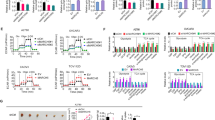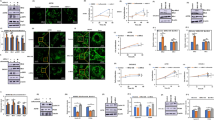Abstract
Purpose
p53 targeted to the mitochondria is the fastest and most direct pathway for executing p53 death signaling. The purpose of this work was to determine if mitochondrial targeting signals (MTSs) from pro-apoptotic Bak and Bax are capable of targeting p53 to the mitochondria and inducing rapid apoptosis.
Methods
p53 and its DNA-binding domain (DBD) were fused to MTSs from Bak (p53-BakMTS, DBD-BakMTS) or Bax (p53-BaxMTS, DBD-BaxMTS). Mitochondrial localization was tested via fluorescence microscopy in 1471.1 cells, and apoptosis was detected via 7-AAD in breast (T47D), non-small cell lung (H1373), ovarian (SKOV-3) and cervical (HeLa) cancer cells. To determine that apoptosis is via the intrinsic apoptotic pathway, TMRE and caspase-9 assays were conducted. Finally, the involvement of p53/Bak specific pathway was tested.
Results
MTSs from Bak and Bax are capable of targeting p53 to the mitochondria, and p53-BakMTS and p53-BaxMTS cause apoptosis through the intrinsic apoptotic pathway. Additionally, p53-BakMTS, DBD-BakMTS, p53-BaxMTS and DBD-BaxMTS caused apoptosis in T47D, H1373, SKOV-3 and HeLa cells. The apoptotic mechanism of p53-BakMTS and DBD-BakMTS was Bak dependent.
Conclusion
Our data demonstrates that p53-BakMTS (or BaxMTS) and DBD-BakMTS (or BaxMTS) cause apoptosis at the mitochondria and can be used as a potential gene therapeutic in cancer.









Similar content being viewed by others
Abbreviations
- 7-AAD:
-
7-Aminoactinomycin D
- BakMTS:
-
MTS from Bak
- BaxMTS:
-
MTS from Bax
- CCO:
-
MTS from cytochrome c oxidase
- CS:
-
C-segment
- DBD:
-
DNA binding domain
- E:
-
Nuclear export signal
- MBD:
-
MDM2 binding domain
- MDM2:
-
Murine double minute 2
- MOMP:
-
Mitochondrial outer membrane permeabilization
- MTS:
-
Mitochondrial targeting signal
- NLS:
-
Nuclear localization signal
- OTC:
-
MTS from ornithine transcarbamylase
- PCC:
-
Pearson’s correlation coefficient
- PRD:
-
Proline-rich domain
- TA:
-
Transactivation domain
- TD:
-
Tetramerization domain
- TM:
-
Transmembrane
- TMRE:
-
Tetramethylrhodamine, ethyl ester
- TOM:
-
MTS from translocase of the outer membrane (TOM20)
- XL:
-
MTS from Bcl-XL
REFERENCES
Haupt S, Berger M, Goldberg Z, Haupt Y. Apoptosis —the p53 network. J Cell Sci. 2003;116(Pt 20):4077–85.
Davis JR, Mossalam M, Lim CS. Controlled access of p53 to the nucleus regulates its proteasomal degradation by MDM2. Mol Pharm. 2013;10(4):1340–9.
Weinberg RL, Freund SM, Veprintsev DB, Bycroft M, Fersht AR. Regulation of DNA binding of p53 by its C-terminal domain. J Mol Biol. 2004;342(3):801–11.
Mihara M, Erster S, Zaika A, Petrenko O, Chittenden T, Pancoska P, et al. p53 has a direct apoptogenic role at the mitochondria. Mol Cell. 2003;11(3):577–90.
Shaulsky G, Goldfinger N, Ben-Ze’ev A, Rotter V. Nuclear accumulation of p53 protein is mediated by several nuclear localization signals and plays a role in tumorigenesis. Mol Cell Biol. 1990;10(12):6565–77.
Marchenko ND, Wolff S, Erster S, Becker K, Moll UM. Monoubiquitylation promotes mitochondrial p53 translocation. EMBO J. 2007;26(4):923–34.
Perfettini JL, Kroemer RT, Kroemer G. Fatal liaisons of p53 with Bax and Bak. Nat Cell Biol. 2004;6(5):386–8.
Chipuk JE, Kuwana T, Bouchier-Hayes L, Droin NM, Newmeyer DD, Schuler M, et al. Direct activation of Bax by p53 mediates mitochondrial membrane permeabilization and apoptosis. Science. 2004;303(5660):1010–4.
Leu JI, Dumont P, Hafey M, Murphy ME, George DL. Mitochondrial p53 activates Bak and causes disruption of a Bak-Mcl1 complex. Nat Cell Biol. 2004;6(5):443–50.
Hagn F, Klein C, Demmer O, Marchenko N, Vaseva A, Moll UM, et al. BclxL changes conformation upon binding to wild-type but not mutant p53 DNA binding domain. J Biol Chem. 2010;285(5):3439–50.
Tomita Y, Marchenko N, Erster S, Nemajerova A, Dehner A, Klein C, et al. WT p53, but not tumor-derived mutants, bind to Bcl2 via the DNA binding domain and induce mitochondrial permeabilization. J Biol Chem. 2006;281(13):8600–6.
Chipuk JE, Fisher JC, Dillon CP, Kriwacki RW, Kuwana T, Green DR. Mechanism of apoptosis induction by inhibition of the anti-apoptotic BCL-2 proteins. Proc Natl Acad Sci U S A. 2008;105(51):20327–32.
Tait SW, Green DR. Mitochondria and cell death: outer membrane permeabilization and beyond. Nat Rev Mol Cell Biol. 2010;11(9):621–32.
Chowdhury I, Tharakan B, Bhat GK. Caspases —an update. Comp Biochem Physiol B Biochem Mol Biol. 2008;151(1):10–27.
Minn AJ, Rudin CM, Boise LH, Thompson CB. Expression of bcl-xL can confer a multidrug resistance phenotype. Blood. 1995;86(5):1903–10.
Yoshino T, Shiina H, Urakami S, Kikuno N, Yoneda T, Shigeno K, et al. Bcl-2 expression as a predictive marker of hormone-refractory prostate cancer treated with taxane-based chemotherapy. Clin Cancer Res. 2006;12(20 Pt 1):6116–24.
Green DR, Walczak H. Apoptosis therapy: driving cancers down the road to ruin. Nat Med. 2013;19(2):131–3.
Kang MH, Reynolds CP. Bcl-2 inhibitors: targeting mitochondrial apoptotic pathways in cancer therapy. Clin Cancer Res. 2009;15(4):1126–32.
Willis SN, Chen L, Dewson G, Wei A, Naik E, Fletcher JI, et al. Proapoptotic Bak is sequestered by Mcl-1 and Bcl-xL, but not Bcl-2, until displaced by BH3-only proteins. Genes Dev. 2005;19(11):1294–305.
Ku B, Liang C, Jung JU, Oh BH. Evidence that inhibition of BAX activation by BCL-2 involves its tight and preferential interaction with the BH3 domain of BAX. Cell Res. 2011;21(4):627–41.
Schinzel A, Kaufmann T, Schuler M, Martinalbo J, Grubb D, Borner C. Conformational control of Bax localization and apoptotic activity by Pro168. J Cell Biol. 2004;164(7):1021–32.
Ferrer PE, Frederick P, Gulbis JM, Dewson G, Kluck RM. Translocation of a Bak C-terminus mutant from cytosol to mitochondria to mediate cytochrome C release: implications for Bak and Bax apoptotic function. PLoS One. 2012;7(3):e31510.
Nechushtan A, Smith CL, Hsu YT, Youle RJ. Conformation of the Bax C-terminus regulates subcellular location and cell death. EMBO J. 1999;18(9):2330–41.
Pietsch EC, Leu JI, Frank A, Dumont P, George DL, Murphy ME. The tetramerization domain of p53 is required for efficient BAK oligomerization. Cancer Biol Ther. 2007;6(10):1576–83.
Pietsch EC, Perchiniak E, Canutescu AA, Wang G, Dunbrack RL, Murphy ME. Oligomerization of BAK by p53 utilizes conserved residues of the p53 DNA binding domain. J Biol Chem. 2008;283(30):21294–304.
Mossalam M, Matissek KJ, Okal A, Constance JE, Lim CS. Direct induction of apoptosis using an optimal mitochondrially targeted p53. Mol Pharm. 2012;9(5):1449–58.
Matissek KJ, Mossalam M, Okal A, Lim CS. The DNA binding domain of p53 is sufficient to trigger a potent apoptotic response at the mitochondria. Mol Pharm. 2013;10:3592–602.
Constance JE, Woessner DW, Matissek KJ, Mossalam M, Lim CS. Enhanced and selective killing of chronic myelogenous leukemia cells with an engineered BCR-ABL binding protein and imatinib. Mol Pharm. 2012;9(11):3318–29.
Costes SV, Daelemans D, Cho EH, Dobbin Z, Pavlakis G, Lockett S. Automatic and quantitative measurement of protein-protein colocalization in live cells. Biophys J. 2004;86(6):3993–4003.
Bolte S, Cordelieres FP. A guided tour into subcellular colocalization analysis in light microscopy. J Microsc. 2006;224(Pt 3):213–32.
Okal A, Mossalam M, Matissek KJ, Dixon AS, Moos PJ, Lim CS. A chimeric p53 evades mutant p53 transdominant inhibition in cancer cells. Mol Pharm. 2013;10:3922–33.
Schmid I, Krall WJ, Uittenbogaart CH, Braun J, Giorgi JV. Dead cell discrimination with 7-amino-actinomycin D in combination with dual color immunofluorescence in single laser flow cytometry. Cytometry. 1992;13(2):204–8.
Yahagi N, Shimano H, Matsuzaka T, Najima Y, Sekiya M, Nakagawa Y, et al. p53 Activation in adipocytes of obese mice. J Biol Chem. 2003;278(28):25395–400.
Wurstle ML, Laussmann MA, Rehm M. The central role of initiator caspase-9 in apoptosis signal transduction and the regulation of its activation and activity on the apoptosome. Exp Cell Res. 2012;318(11):1213–20.
Darzynkiewicz Z, Bruno S, Del Bino G, Gorczyca W, Hotz MA, Lassota P, et al. Features of apoptotic cells measured by flow cytometry. Cytometry. 1992;13(8):795–808.
Yin Q, Park HH, Chung JY, Lin SC, Lo YC, da Graca LS, et al. Caspase-9 holoenzyme is a specific and optimal procaspase-3 processing machine. Mol Cell. 2006;22(2):259–68.
Nigro JM, Baker SJ, Preisinger AC, Jessup JM, Hostetter R, Cleary K, et al. Mutations in the p53 gene occur in diverse human tumour types. Nature. 1989;342(6250):705–8.
Bodner SM, Minna JD, Jensen SM, D’Amico D, Carbone D, Mitsudomi T, et al. Expression of mutant p53 proteins in lung cancer correlates with the class of p53 gene mutation. Oncogene. 1992;7(4):743–9.
Yaginuma Y, Westphal H. Abnormal structure and expression of the p53 gene in human ovarian carcinoma cell lines. Cancer Res. 1992;52(15):4196–9.
Goodrum FD, Ornelles DA. p53 status does not determine outcome of E1B 55-kilodalton mutant adenovirus lytic infection. J Virol. 1998;72(12):9479–90.
Erster S, Moll UM. Stress-induced p53 runs a direct mitochondrial death program: its role in physiologic and pathophysiologic stress responses in vivo. Cell Cycle. 2004;3(12):1492–5.
Nalepa G, Rolfe M, Harper JW. Drug discovery in the ubiquitin-proteasome system. Nat Rev Drug Discov. 2006;5(7):596–613.
Haupt Y, Maya R, Kazaz A, Oren M. Mdm2 promotes the rapid degradation of p53. Nature. 1997;387(6630):296–9.
Schellenberg B, Wang P, Keeble JA, Rodriguez-Enriquez R, Walker S, Owens TW, et al. Bax exists in a dynamic equilibrium between the cytosol and mitochondria to control apoptotic priming. Mol Cell. 2013;49(5):959–71.
Edlich F, Banerjee S, Suzuki M, Cleland MM, Arnoult D, Wang C, et al. Bcl-x(L) retrotranslocates Bax from the mitochondria into the cytosol. Cell. 2011;145(1):104–16.
ACKNOWLEDGMENTS AND DISCLOSURES
Research reported in this publication was supported by the National Cancer Institute of the National Institutes of Health under award number R01-CA151847. The authors would also like to acknowledge Christian Raab for his technical work. We also would like to thank Ben Bruno and Geoff Miller for reviewing the manuscript. We acknowledge the use of DNA/Peptide Core and Flow Cytometry Core (NCI Cancer Center Support Grant P30 CA042014, Huntsman Cancer Institute).
Author information
Authors and Affiliations
Corresponding author
Rights and permissions
About this article
Cite this article
Matissek, K.J., Okal, A., Mossalam, M. et al. Delivery of a Monomeric p53 Subdomain with Mitochondrial Targeting Signals from Pro-Apoptotic Bak or Bax. Pharm Res 31, 2503–2515 (2014). https://doi.org/10.1007/s11095-014-1346-y
Received:
Accepted:
Published:
Issue Date:
DOI: https://doi.org/10.1007/s11095-014-1346-y




